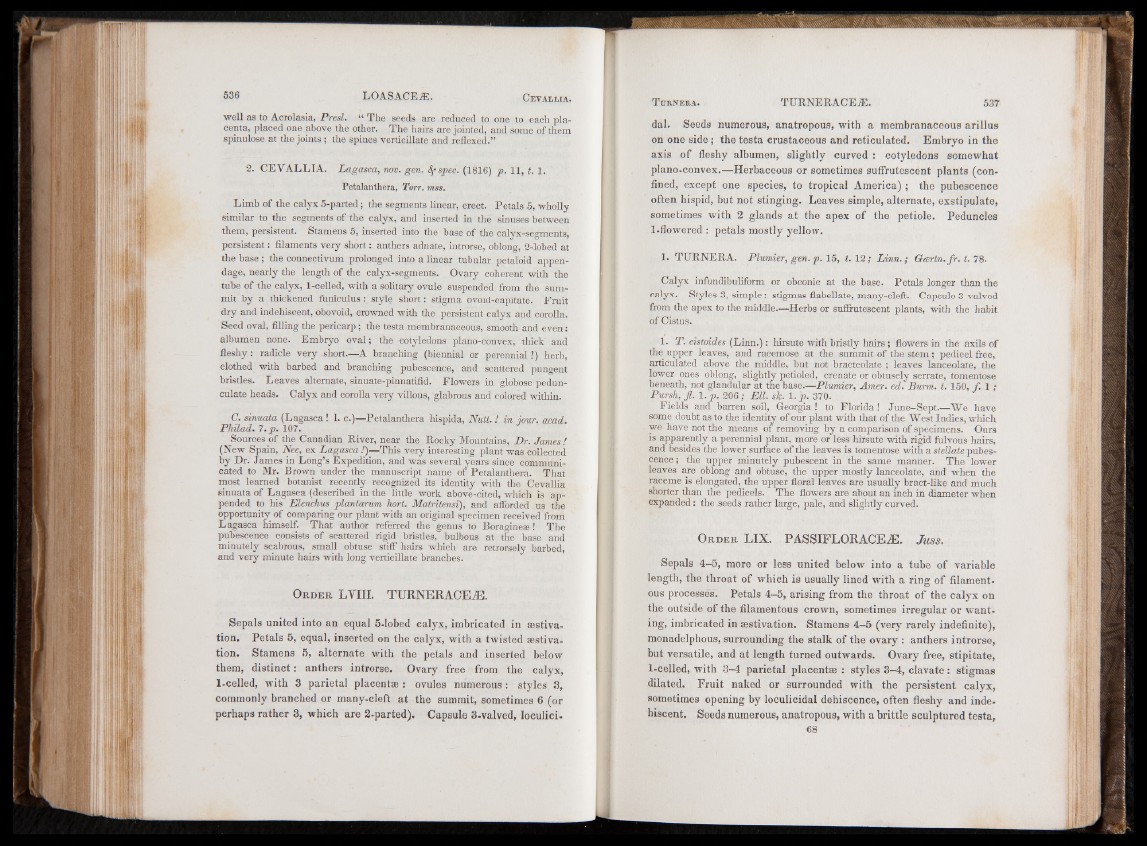
well as to Acrolasia, Presl. “ The seeds are reduced to one to each placenta,
placed one above the other. The hairs are jointed, and some of them
spinulose at the joints ; the spines verticillate and reflexed.”
2. CEYALLIA. Lagasca, nov. gen. 8f spec. (1816) p. 11, t. 1.
Petalanthera, Torr. mss.
Limb of the calyx 5-parted ; the segments linear, erect. Petals 5, wholly
similar to the segments of the calyx, and inserted in the sinuses between
them, persistent. Stamens 5, inserted into the basé of the calyx-segments,
persistent : filaments very short : anthers adnate, introrse, oblong, 2-lobed at
the base ; the connectivum prolonged into a linear tubular petaloid appendage,
nearly the length of the calyx-segments. Ovary coherent with the
tube of the calyx, 1-celled, with a solitary ovule suspended from the summit
by a thickened funiculus : style short : stigma ovoid-capitate. Fruit
dry and indéhiscent, obovoid, crowned with the persistent calyx and corolla.
Seed oval, filling the pericarp ; the testa membranaceous, smooth and even :
albumen none. Embryo oval; the cotyledons plano-convex, thick and
fleshy: radicle very short.—A branching (biennial or perennial?) herb,
clothed with barbed and branching pubescence, and scattered pungent
bristles. Leaves alternate, sinuate-pinnatifid. Flowers in globose pedunculate
heads. Calyx and corolla very villous, glabrous and colored within.
C. sinuata (Lagasca ! 1. c.)—Petalanthera hispida, Nuit. ! in jour. acad.
Philad. 7. p. 107.
Sources of the Canadian River, near the Rocky Mountains, Dr. James !
(New Spain, Nee, ex Lagasca!)—This very interesting plant was Collected
by Dr. James in Long’s Expedition, and was several years since communicated
to Mr. Brown under the manuscript name of Petalanthera. That
most learned botanist recently recognized its identity with the Cevallia
sinuata of Lagasca (described in the little work above-cited, which is appended
to his Elenchus plantarum hort. Matritensi), and afforded us the
opportunity of comparing our plant with an original specimen received from
Lagasca himself. That author referred the genus to Boragineæ ! The
pubescence consists of scattered rigid bristles, bulbous at the base and
minutely scabrous, small obtuse stiff hairs which are retrorsely barbed,
and very minute hairs with long verticillate branches.
Or d e r LYIII. TURNERACEiE.
Sepals united into an equal 5-lobed calyx, imbricated in aestivation.
Petals 5, equal, inserted on the calyx, with a twisted aestivation.
Stamens 5, alternate with the petals and inserted below
them, d is tin c t: anthers introrse. Ovary free from the calyx,
1-celled, with 3 parietal placentae : ovules numerous : styles 3,
commonly branched or many-cleft a t the summit, sometimes 6 (or
perhaps ra ther 3, which are 2-parted). Capsule 3-valved, loculicidal.
Seeds numerous, anatropous, with a membranaceous arillus
on one sid e ; the testa crustaceous and reticulated. Embryo in the
axis of fleshy albumen, slightly curved : cotyledons somewhat
plano-convex.—Herbaceous or sometimes suffrutescent plants (confined,
except one species, to tropical America) ; the pubescence
often hispid, but not stinging. Leaves simple, alternate, exstipulate,
sometimes with 2 glands a t the apex o f the petiole. Peduncles
1-flowered : petals mostly yellow.
1. TURNERA. Plumier, gen.p. 15, t. 12,• Linn.; Geertn. fr . t. 78.
Calyx infundibuliform or obconic at the base. Petals longer than the
calyx. Styles 3, simple: stigmas flabeflate, many-cleft. Capsule 3-valved
from the apex to the middle.—Herbs or suffrutescent plants, with the habit
of Cistus.
1. T. cistoides (Linn.): hirsute with bristly hairs ; flowers in the axils of
the upper leaves, and racemose at the summit of the stem; pedicel free,
articulated above the middle, but not bracteolate ; leaves lanceolate, the
lower ones oblong, slightly petioled, crenate or obtusely serrate, tomentose
beneath, not glandular at the base.—Plumier, Amer. ed. Burm. t. 150, f . 1 ;
Pursh, fi. l. p. 206; Ell. sic. \. 'p. 370.
Fields and barren soil, Georgia! to Florida! June-Sept.—We have
some doubt as to the identity of our plant with that of the West Indies, which
we have not the means of removing by a comparison of specimens. Ours
is apparently a perennial plant, more or less hirsute with rigid fulvous hairs,
and besides the lower surface of the leaves is tomentose with a stellate pubescence
; the upper minutely pubescent in the same manner. The lower
leaves are oblong and obtuse, the upper mostly lanceolate, and when the
raceme is elongated, the upper floral leaves are usually bract-like and much
shorter than the pedicels. The flowers are about an inch in diameter when
expanded: the seeds rather large, pale, and slightly curved.
Or d e r LIX. PASSIFLORACEÆ. Juss.
Sepals 4-5, more or less united below into a tube o f variable
length, the throat of which is usually lined with a ring of filamentous
processes. Petals 4-5, arising from the throat of the calyx on
the outside of the filamentous crown, sometimes irregular or w an ting,
imbricated in aestivation. Stamens 4—5 (very rarely indefinite),
monadelphous, surrounding the stalk of the ovary : anthers introrse,
but versatile, and a t length turned outwards. Ovary free, stipitate,
1-celled, with 3-4 parietal placentae : styles 3-4, clavate : stigmas
dilated. Fruit naked or surrounded with the persistent calyx,
sometimes opening by loculicidal dehiscence, often fleshy and indéhiscent.
Seeds numerous, anatropous, with a brittle sculptured testa,
68